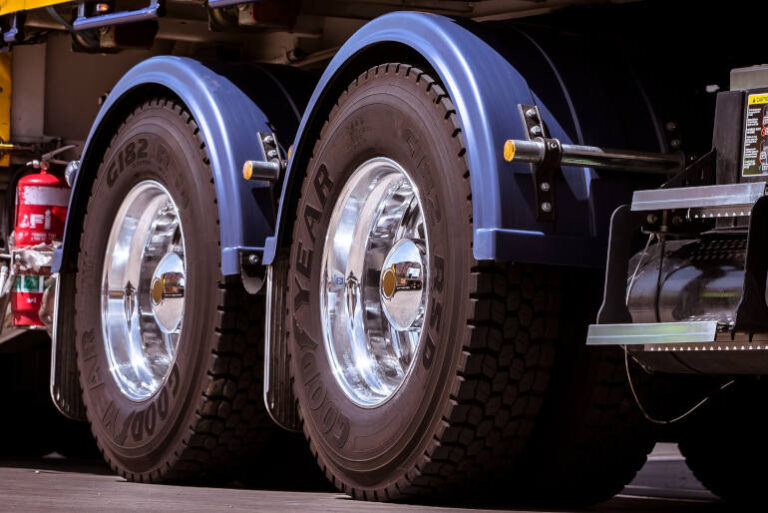A seemingly small change in tyre regulations under the latest ADR80/04 emissions standards is poised to have a significant impact on the Australian transport and tyre industries. Operators of heavy-duty trucks fitted with compliant Euro 6 engines can now unlock an additional 500kg of Gross Vehicle Mass (GVM) — simply by switching to 315/70R22.5 steer tyres.
While ADR80/04 primarily focuses on reducing emissions and ensuring cleaner air through Euro 6 engine compliance, it’s the knock-on effect of axle and tyre specification changes that is set to shift long-standing industry practices. The increased payload capacity is a direct result of higher axle weight allowances when specific tyre configurations are used — and it’s the adoption of 315/70R22.5 steer tyres that’s the key.
From 295 to 315: The European Influence
For decades, 295/80R22.5 has been the steer tyre of choice for most heavy-duty truck operators in Australia. It’s a familiar size, well-supported by local dealers, and deeply integrated into fleet maintenance programs.
But with the ADR80/04 rule changes and new truck models like the Isuzu FX and FY series now homologated to run on 315/70R22.5 tyres, that tradition could be set to change.
According to Simon Humphries, Head of Product Management at Isuzu Trucks, this update wasn’t an afterthought. “We anticipated what the NHVR and the government were doing in terms of allowances for Euro 6 or ADR80/04 trucks, and we were able to specify the 315-section tyres on our FV and FX models in time for the release,” Humphries said during the new range launch briefing.
The result? “Our customers have access to an additional half-tonne of GVM,” he explained, “which means more payload, despite the trucks being a bit heavier due to the new emissions equipment and upgraded chassis.”
What’s the Big Deal?
In practical terms, the additional 500kg in payload capacity can translate to more freight per trip, fewer runs, and better productivity — especially critical in high-volume operations like general freight, fuel transport, or construction materials.
For tyre suppliers, this presents a dual challenge and opportunity. The 315/70R22.5 size has long been a staple in Europe, where it’s often specified for steer and drive axles across a variety of vehicle configurations. However, Australian supply chains and stock levels have historically prioritised the 295 profile.
The growing number of Euro 6 trucks entering the market — and now this added incentive for operators to switch — could tip the balance and drive greater demand for 315/70R22.5 tyres across the country.
Implications for Fleets and Tyre Suppliers
Fleet managers will need to review their purchasing policies, especially if they are procuring new ADR80/04-compliant trucks. Fitting the right tyre size at the point of purchase can mean the difference between accessing that additional GVM or missing out.
Tyre retailers and OEM suppliers will also need to adjust their stock planning and technical support. Many fleets run mixed vehicle types, and adding a new steer tyre size into rotation will affect spare inventory, fitment processes, and staff training.
From a compliance perspective, operators need to be aware that this increase in GVM is only permissible if the 315/70R22.5 steer tyres are fitted — and they must match the approved vehicle configuration. Simply swapping tyres on an older truck won’t grant the same benefit unless the vehicle itself is certified under the new ADR80/04 guidelines.
Isuzu Leads the Charge
Isuzu’s new heavy-duty FX and FY models are among the first in Australia to fully embrace the change. As part of its 2025 model overhaul, the brand has prioritised the integration of the larger tyres, upgraded axle ratings, and Euro 6 powertrains across its flagship models.
The company has confirmed that both the FX and FY series are shipping with 7.3-tonne front axles and 315/70R22.5 steer tyres as standard. These models now enjoy improved braking, increased payloads, and upgraded safety systems — including full air disc brakes, electronic brake systems (EBS), and Lane Keep Assist.
This strategic alignment with future-facing compliance standards positions Isuzu to meet growing demands from operators who are under pressure to improve efficiency, reduce emissions, and manage rising operating costs.
A Turning Point for the Industry
While this change may appear technical, it represents a shift in how vehicle design, compliance, and productivity are converging. Tyres, once considered a maintenance item, are now part of the strategic decision-making for heavy vehicle operators looking to maximise return on investment.
The long-dominant 295/80R22.5 size won’t disappear overnight, but its reign as the default steer tyre for Australian fleets is under challenge. With OEMs like Isuzu specifying 315/70R22.5 from the factory — and the lure of extra payload — it’s only a matter of time before tyre yards and transport depots across the country start seeing more of the wider, lower-profile rubber rolling through the gates.
Fleet News Group Insight
Fleet Managers and procurement specialists should consult with their OEM and tyre supplier to confirm vehicle compliance and understand the practical impacts of tyre size changes on GVM, payload, and servicing. It’s a change that goes beyond the rubber — and into the heart of fleet productivity.






